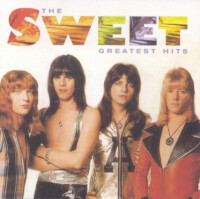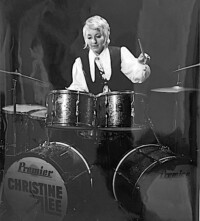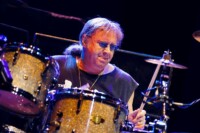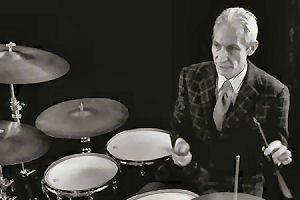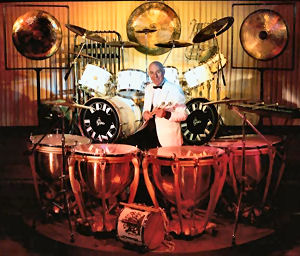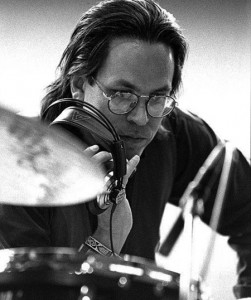 I first met Jeff Porcaro at a Music Trade Show in London at Alexandra Palace in London. As far as I can see, it was the first and the only musical instrument show to be held there although gigs still go on there even as we speak.
I first met Jeff Porcaro at a Music Trade Show in London at Alexandra Palace in London. As far as I can see, it was the first and the only musical instrument show to be held there although gigs still go on there even as we speak.
I’m pretty sure I still owned a drum shop at the time and was also there to write a piece about the show for ‘International Musician Magazine’ and negotiations were going on for me to join the Kinks so my best guess is that it was in the summer of 1983. This was the year when the ‘Porcaro Rack’ was launched so it would make sense that he was in the UK to publicise it – but more of this later.
Jeff came over to me said hello and first shook hands with my six year old son and asked his name. He and I chatted about drums, drumming and the road going ever on, as we drummers do. And that was that – I didn’t see him again.
Jeffrey Thomas Porcaro was born in Hartford, Connecticut on April 1st, 1954. His father Joe is of course a celebrated percussionist and it was he who started giving all his sons drum lessons. Jeff started his lessons at the drum shop where his dad taught when he was seven years old and carried on until he was 11.
Jeff’s uncle Emil Richards was another eminent percussionist, who played with a completely diverse bunch of musicians – including, among many others, the Hartford Symphony Orchestra, Charles Mingus and George Shearing. Having spent a lot of time there, he knew exactly what Los Angeles had to offer a good musician. It was at his suggestion that the family upped-sticks and moved to America’s considerably more benevolent, not to say family-friendly (and warmer) West Coast. It would also be a considerably more lucrative situation to be working in for Joe Porcaro.
 In 1968 the family found themselves living in Van Nuys in the San Fernando Valley where Jeff attended The Ulysses S. Grant High School which had a great many other soon-to-be-famous musical alumni such as David Paich, Jim Gordon, John Dolmayan, Micky Dolenz, Mike Post, Steve Lukather, Tom Scott and Jeff’s brothers Mike and Steve.
In 1968 the family found themselves living in Van Nuys in the San Fernando Valley where Jeff attended The Ulysses S. Grant High School which had a great many other soon-to-be-famous musical alumni such as David Paich, Jim Gordon, John Dolmayan, Micky Dolenz, Mike Post, Steve Lukather, Tom Scott and Jeff’s brothers Mike and Steve.
It was at this time that Bob Zimmitti (who played with Frank Zappa) and a chap called Richie Laporte started to coach Jeff. His favourite drummers at the time – other than the jazz players like Elvin Jones, Philly Joe Jones and Art Blakey his father had exposed him to – were Jim Keltner and Jim Gordon.
The Porcaros were living in Sherman Oaks while Jeff was attending High school, where he started playing in a band with keyboard player David Paich. The band was originally called ‘The Merciless Souls’, but ultimately changed its name to ‘Rural Still Life’. He was also in the school’s marching band too and having joined it at sixteen, stories on the internet say that he took it over and “funkified the cadence”.
He’d practice drums every day, playing to The Beatles and Jimi Hendrix once he got home from school, but insisted he didn’t want to be a drummer at all – he wanted to be an artist! It seems there was a time when he wasn’t even the best drummer in the Porcaro family – his brother Mike was, although he eventually switched to bass. Apparently there’s no truth in the rumour that Mike played bass and Steve played keyboards just so the family would have a better band for their Christmas parties!
Around the time he was 17 he played on his earliest album and this led almost directly to his first professional gig, a prime-time ‘Comedy Hour’ TV show with Sonny and Cher which he took instead of graduating from High School. This was a result of being in a rehearsal band with Jim Keltner where he met David Hungate (who eventually became Toto’s bass player) and they went together with Dean Parks to Leon Russell’s house to do a demo for no fee. There’s a fabulous story I found about Jeff knowing he would be meeting Jim Keltner for the first time and throwing up on the way! Hungate and Parks rowed him into their gig and having decided not to graduate properly, Jeff found himself in Las Vegas, on tour with Sonny and Cher and earning $500 a week.
 From here in 1973 he was playing at a club called Donte’s in North Hollywood with Seals and Crofts with whom he’d had his first hit record with “Diamond Girl” when Donald Fagen and Walter Becker wandered in for a drink and spotted him. Steely Dan were in the studio and invited him to record ”Pretzel Logic” with them and then to go on the road as their permanent drummer. So Jeff swapped “I Got You Babe” for “Reeling In The Years” and the rest, as I seem to say frequently in Groovers and Shakers, is history.
From here in 1973 he was playing at a club called Donte’s in North Hollywood with Seals and Crofts with whom he’d had his first hit record with “Diamond Girl” when Donald Fagen and Walter Becker wandered in for a drink and spotted him. Steely Dan were in the studio and invited him to record ”Pretzel Logic” with them and then to go on the road as their permanent drummer. So Jeff swapped “I Got You Babe” for “Reeling In The Years” and the rest, as I seem to say frequently in Groovers and Shakers, is history.
In his time Jeff played on record with a really long list of guys but, in the interests of saving space and pixels, I’ll give you just a few to whet your appetite – Al Jarreau, Barbra Streisand, Boz Scaggs, Bruce Springsteen, David Gilmour. Diana Ross, Dire Straits, Donald Fagen, Donna Summer, Elton John, Eric Clapton, George Benson, Jim Messina, Joe Cocker, Joe Walsh, Michael Jackson, Michael McDonald, Miles Davis, Paul McCartney, Pink Floyd, Rickie Lee Jones, Seals and Crofts, Sergio Mendes, Stan Getz, and Steely Dan. A great many of these recording sessions resulted in huge hits and there are no prizes for knowing who he was playing with when he made “Thriller”, “Beat it”, “Pretzel Logic”, “The Girl Is Mine”, “Like A Prayer”, “Give My Regards To Broad Street”, “Summer Nights”, “Nobody Does It Better”, or even “The Wall”.
Eventually Jeff and his friends and relatives – David Paich, Dave Hungate, Steve Lukather, Bobby Kimball and Steve Porcaro – put together something great of their own, eventually calling the results of their endeavours, ‘Toto’. There is a story that Jeff wrote Toto (meaning ‘in all’ in the Latin we had to learn in secondary School) on the boxes the newly recorded tapes were in, to distinguish them from others in the studio – but I don’t buy that. I much prefer to think that the name came from Dorothy’s dog who was the cause of all the trouble in ‘The Wizard of Oz’ as in: “Toto, I’ve a feeling we’re not in Kansas anymore!”.
Believe it or don’t, the band’s raison d’etre when they began was to make ‘Triple Platinum’ albums. For those who don’t move in those exalted circles, that is shorthand for ‘three million sales’ – although that triple designation doesn’t actually exist. The record business makes do with ‘multi-platinum’ which is for sales in excess of two million. The next milestone in album sales is ‘Diamond’ which signifies 10 million sales. The band’s first album, simply called Toto came out in 1978, was highly successful and sold two million units. But it fell short of their original ambitious goal – the number three followed by six zeros after the dollar sign! They had to wait until Toto IV to achieve that magic number but I’m sure it was worth it because the album brought them no less than six Grammy awards including ‘Record of the year’ for “Rosanna”, ‘Album of the year’ and ‘Producer of the year’.
This degree of success was hard to follow although their traditionally ‘difficult second album’ “Hydra” certainly sold a million in 1979. Jeff’s last Toto album (of eight) came out in 1992 and was called “Kingdom Of Desire”.
N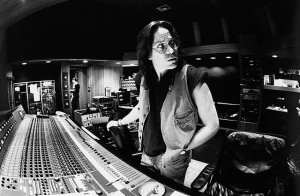 ow we come to the part of the Jeff Porcaro story which most articles about him seem to major on: the unfortunate circumstances surrounding his untimely death. There was so much more about Jeff Porcaro than his demise which has unsympathetically found its way into rock folklore. Suffice it to say he died, long before his time, from cocaine use (according to the post mortem) so he wasn’t able to show the drum world what his drumming genius was going to come up with next.
ow we come to the part of the Jeff Porcaro story which most articles about him seem to major on: the unfortunate circumstances surrounding his untimely death. There was so much more about Jeff Porcaro than his demise which has unsympathetically found its way into rock folklore. Suffice it to say he died, long before his time, from cocaine use (according to the post mortem) so he wasn’t able to show the drum world what his drumming genius was going to come up with next.
His heroes were Steve Gadd, Jim Gordon, and Harvey Mason and like all drummers he’s borrowed from them and others. But unlike other drummers he wasn’t afraid to admit it. As he confessed in a Modern Drummer interview in 1983:
“A drummer’s own style [will come] from being on his own, but I copied Gordon and Keltner and all these guys. I remember realising this, but after a while the accumulation of all the guys you copy becomes your own thing – hopefully.”
Aside from “Rosanna” I’m partial to “Lido Shuffle” which is a track Jeff played on for Boz Scaggs in 1976. This was when he was in his backing group and is a song which I’ve played a few times in more-ambitious bands. Jeff says he stole this from the feel Jim Gordon played on Steely Dan’s “Charlie Freak” – although he speeded it up.
I‘ve done a lot of research into Jeff Porcaro and come up with some interesting and highly poignant ‘In Memoriae’ from the many pals who played with him on countless recording sessions and of course in Toto. He has over the years been offered (and turned down) many permanent, not to say lucrative gigs like Bruce Springsteen and Dire Straits, because he just didn’t want to be on the road and away from his family anymore.
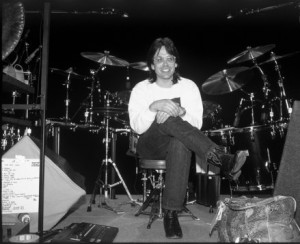 His brother Steve said of him:
His brother Steve said of him:
“Jeff always had a huge part in making a song a record. You felt like you were capturing lightning in the studio. It was never boring. He always was there to serve the song. He always came up with the best parts instantly, like he’d been playing the song for years. Even looking back, you realise he made all these great choices whether he was being implicit or explicit that have really stood the test of time.”
Gregg Bissonette said:
“Jeff was a great friend and definitely one of my drum heroes. His groove was incredibly deep and he always knew what to play. His body of work is unreal . I sure do miss him and miss going to see him play at The Baked Potato.”
Simon Phillips replaced him in Toto and said, on what would have been Jeff’s 63rd birthday recently:
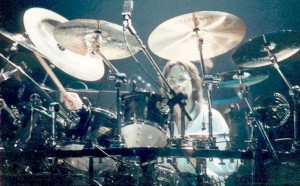 “It’s been nearly 25 years since we lost Jeff in ’92. I had only met him a couple of times but since joining Toto and spending 21 years with the band I feel I have gotten to know him through Mike Luke and Paich. When I lived in London I would hear records that Jeff played on and I always felt he played with such maturity – he sounded older than he was. He has a wonderful knack of knowing exactly what to play and when to play it and he always played for the song. Such musicality and I appreciated that so much!”
“It’s been nearly 25 years since we lost Jeff in ’92. I had only met him a couple of times but since joining Toto and spending 21 years with the band I feel I have gotten to know him through Mike Luke and Paich. When I lived in London I would hear records that Jeff played on and I always felt he played with such maturity – he sounded older than he was. He has a wonderful knack of knowing exactly what to play and when to play it and he always played for the song. Such musicality and I appreciated that so much!”
David Paich said of him:
“When we did a take on a record, he was usually the first one to get a good take. Having grown up in a time before drum machines, I think he had the best time and groove of any drummer I’ve ever played with. He also had the kick and power of a Big Band drummer.”
Dave Hungate said:
“Jeff had a rare combination of a brilliant mind and a sensitive artists’ soul. To many he became the standard by which drummers were judged yet to refer to Jeff only as a drummer is to somehow overstate the case. He was a composer, arranger and a formidable wit who happened to express himself through his playing. “
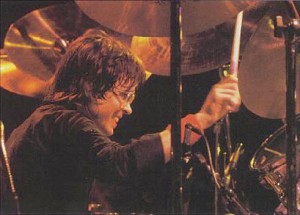 His great hero, Jim Keltner called him: “the most unusual, dynamic person I’ve ever met.”
His great hero, Jim Keltner called him: “the most unusual, dynamic person I’ve ever met.”
As far as drums are concerned he seems to have had more of them than you could shake a stick at. Think of a drum and you’ll find that he, or Ross Garfield, ’The Drum Doctor’ who looked after his drums and their cartage, had one of them. If not, it seems Ross Garfield would simply build Jeff one!
He started out with a Slingerland set in Champagne Sparke with a brass-shelled snare which a friend of his father won in a poker game and Joe bought for Jeff for not much money – complete with cases and cymbals. There are conflicting stories about his selection of later gear although it’s clear he preferred the warm sound of wood-shelled drums rather than anything built from fiberglass, plexiglass, or phenolic. One story is that he always used a Gretsch set in the studio – 22 x 16, 10 x 8, 12 x 8, 13 x 9 with a 14 x 14 floor tom – although he switched the bass to a 2” deeper version. All these drums were used with an engraved 14 x 5” Ludwig Black Beauty from the seventies. This drum was eventually fitted with a ‘Reverse CS’ coated batter for more ‘crack’. While I’m on the subject, he changed the heads on his recording sets every three days. Paul Jamieson, who did Jeff’s cartage and set-up from 1976 to 1988, modified a 14 x 6.5” Radio King snare drum which he evidently used a great deal at one time.
Besides the Gretsch set, there is talk of him recording with a Slingerland set with a 28” bass drum and no less than three Ludwig sets – two with 22” basses and another with a 24”. He also had a 26” bass just in case. One set I didn’t know he had, although I’d very nearly bought a red lacquered version of it in Frank Ippolito’s Professional Percussion in New York City, was a black Camco with 24” bass drum and completely brass fittings.
At the beginning of Toto he was using a Ludwig set with power toms and in 1982 he became a Pearl endorser and religiously used their drums live starting with a 6-ply Rosewood kit with eight toms. By the time he got round to Toto’s album ‘The Seventh One’ he had a maple set from Pearl with regular depths. He seems to have been using a Ludwig 402 snare drum at this time. By the time it came to recording “Kingdom of Desire” he had an ‘MLX’ sometimes with a 14 x 3.5” Free Floating’ brass, or a regular 5.5 x 14” Steel shell, both from Pearl. He also owned a Brady ply constructed set in Jarah and silver gimlet.
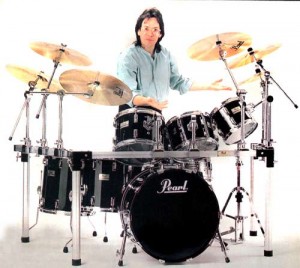 This liaison with Pearl enabled him to produce, with the help of Paul Jamieson from Studio Drum Rentals in LA, the DR-1 Porcaro Rack. This piece of equipment for many of us Pearl endorsers (and others who weren’t ) touring in the eighties, became essential equipment for our drum kits – just so long as we didn’t have to carry them! The reason I personally couldn’t do without mine was because it was very easy for the drum tech to get the bass drum out if you broke a head – without having to dismantle the toms.
This liaison with Pearl enabled him to produce, with the help of Paul Jamieson from Studio Drum Rentals in LA, the DR-1 Porcaro Rack. This piece of equipment for many of us Pearl endorsers (and others who weren’t ) touring in the eighties, became essential equipment for our drum kits – just so long as we didn’t have to carry them! The reason I personally couldn’t do without mine was because it was very easy for the drum tech to get the bass drum out if you broke a head – without having to dismantle the toms.
Strangely he something interesting to say about his equipment:
“Drums are drums, depending on the choice of head and how you tune them. Sometimes just the look of one will make me partial to that one for two weeks – just because it looks different and it’s new.”
His cymbals at one time were all ‘borrowed’ from his father but eventually he got his own 2002, 602 and Signature series from Paiste. These were a 22” Ride, 14” Heavy hats, 19 and 21” Crashes and 20” China-type.
He claimed he wasn’t actually into electronic drums, although he used a Dynacord ‘Add-One’ for his gong and ‘gated’ timbales sounds on the road. He also had a set of Joe Pollard’s ‘Syndrums’ which he used to great effect on Carly Simon and James Bond’s “Nobody Does It Better”. ‘The Spy Who Loved Me’ wasn’t the only film tune he was on. He also played on the scores for among many others: ‘Arthur’, ‘An Officer And A Gentleman’, ‘Dune’ and even ’Sgt Pepper’.
Like his father, Jeff started out playing with a traditional stick grip but eventually (also like his father) switched to ‘matched’ grip. Joe of course was a tympani and tuned percussion player so was used to holding his sticks parallel, so to switch wasn’t too difficult for him. I read somewhere he was happy to teach his students either way. Jeff though was having problems with callouses on the middle finger of his left hand and knew he needed to change, even though he said he didn’t have the chops he’d had before. I’ve searched to no avail to find the date when he changed so we can see exactly when, according to him, he lost his chops. He also told a magazine his timing sucked. Yeah right!
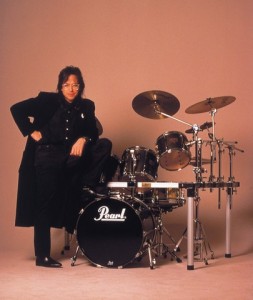 As far as his playing is concerned it’s a good bet that most drummers still consider he was ‘The Man’ – everything he played was just right. Even his trade-mark pattern for Rosanna, which is ostensibly The Purdie half-time shuffle groove as played by Bonham and Bernard himself, is made considerably more tricky to execute by the fact that Jeff’s bass drum was playing a ‘hambone’ pattern. And, to put it into perspective, it turns out this piece was done in one take and the outro was simply a spontaneous jam!
As far as his playing is concerned it’s a good bet that most drummers still consider he was ‘The Man’ – everything he played was just right. Even his trade-mark pattern for Rosanna, which is ostensibly The Purdie half-time shuffle groove as played by Bonham and Bernard himself, is made considerably more tricky to execute by the fact that Jeff’s bass drum was playing a ‘hambone’ pattern. And, to put it into perspective, it turns out this piece was done in one take and the outro was simply a spontaneous jam!
Jeff Porcaro aka ‘The man with the golden groove’ died on August 5th, 1992 and I wasn’t completely surprised considering the huge wealth of recording sessions he’d played on, to find an interview where he admitted he didn’t really enjoy all of the music he was doing in the studios – other than his own with Toto that is! This may well have been written after what turned-out to be his ‘difficult’ time doing a session with Ricky Lee Jones. You can read about this on www.toto-music.web.
As is my wont with Groovers and Shakers, I scoured the internet to find-out what Buddy Rich had to say about Jeff Porcaro and found nothing. This is possibly a very good sign!
I came upon a quote from Jeff which sums the art of drumming up.
“The best thing for drummers is to have fun. Even if you’re falling apart inside you have a great outlet to express your emotions, whether you realise it or not.”
Amen to that.
Bob Henrit
June 2017

